Back to Courses









Business Strategy Courses - Page 21
Showing results 201-210 of 543

Grow to Greatness: Smart Growth for Private Businesses, Part I
This course, developed at the Darden School of Business at the University of Virginia and taught by top-ranked faculty, focuses on challenges faced by existing private businesses when they attempt to grow substantially.

Gain Actionable Feedback with a 4Ls Retrospective in Miro
By the end of this project, you will be able to lead and document a 4 Ls project retrospective to explore lessons learned while focusing on actions and improvements.
To do this, you will gain hands-on experience working in the Miro online visual collaboration platform for teamwork while you build trust, improve morale, and increase engagement during a project retrospective.
Note: This course works best for learners who are based in the North America region. We’re currently working on providing the same experience in other regions.

Generate an Opportunity Solution Tree in Miro
By the end of this project, you will be able to create an opportunity solution tree to outline how your team will reach a desired outcome.
To do this, you will gain hands-on experience framing decisions, aligning a team to a shared understanding, and charting the path toward the preferred outcome in the Miro online visual collaboration platform for teamwork.
Note: This course works best for learners who are based in the North America region. We’re currently working on providing the same experience in other regions.

Make a Flowchart with Mockitt
Think about decisions you make every day and the processes that you use. Have you ever seen them laid out in a chart format? Flowcharts can be used to develop a process or outline steps. Flowcharts are a great tool to use to plan your websites or apps and to figure out complicated processes. In this project, you will learn more about the steps to making a flowchart, and you will use Wondershare Mockitt to make a flowchart.

Macroeconomic Financial Accounts
This course is primarily aimed at undergraduates attending their final year or University students in monetary and financial economics, international macroeconomics and data mining. Professionals in Government institutions, Central Banks, business and the financial industry, along with other professionals interested in finance and macroeconomics, may also benefit from this course. The lectures, the tutorials and the activities lead the participants, step-by-step, through the system of financial accounts and provide unique hands-on guides to the macroeconomic databanks of the major national and international institutions (OECD, European Central Bank, US Federal Reserve System, Bank for International Settlements, IMF). At the end of the course students will gain a clear overview of the financial connections among the institutional sectors in market economies. Student activities include manipulations of data obtained from institutional websites with spreadsheets in order to construct tables and graphs.

Validating Your Startup Idea with MVP Experiment Canvas
By the end of this guided project, you will be able to use the Minimum Viable Product (MVP) Experience Canvas to test your startup business model assumptions. An MVP is a version of a new product which allows a team to collect the maximum amount of validated learning about customers with the least effort. The MPV Experiment Canvas is a framework that help you determine the desirability, viability, and feasibility of your business idea. The model has 12 building blocks that help you to systematically analyze your idea from defining the targeted customers, to experimenting with the model, and to making strategic decisions with the results of the analysis conducted.
For us to practically demonstrate how to use the Canvas to conduct analysis and validate a business idea, we will analyze a Fintech startup company as a case study. Example of the case study would empower you to apply the model to startup, or any venture of your choice. The project is for entrepreneurs who want to avoid the costly mistake of launching a product that nobody needs. Also, for intrapreneurs and business leader that want to experiment and validate a business idea before making significant investment. At the end of the project, you will be able to use the canvas to determine your product-market fit

AI For Everyone
AI is not only for engineers. If you want your organization to become better at using AI, this is the course to tell everyone--especially your non-technical colleagues--to take.
In this course, you will learn:
- The meaning behind common AI terminology, including neural networks, machine learning, deep learning, and data science
- What AI realistically can--and cannot--do
- How to spot opportunities to apply AI to problems in your own organization
- What it feels like to build machine learning and data science projects
- How to work with an AI team and build an AI strategy in your company
- How to navigate ethical and societal discussions surrounding AI
Though this course is largely non-technical, engineers can also take this course to learn the business aspects of AI.

Artificial Creativity
Artificial Creativity explores the emerging field of creativity in artificial intelligence (AI) from a design perspective, bringing together insights from computer science and creative disciplines. In this course, you will survey the history and theories behind today's creative AI, analyze the unorthodox approaches that have advanced the field, and experience cutting-edge creative AI tools. At the same time, you will learn design thinking research methods, how to implement them for your creative insights, and how to translate them to professional and business contexts. Throughout the course, you will step away from your computer to conduct design research, applying the techniques and theories you learn each week to a topic of your choice. You will also engage with other learners through discussions while challenging and expanding your understanding of creativity.
Evaluating the Quality of Healthcare Delivery
In this course, you will have the opportunity to learn about the great progress that has been made in measuring and evaluating quality of care. We will discuss key concepts and methods. You will also learn about how to use websites for comparing the quality of healthcare providers. The course content is intended for a wide range of participants – for example, people who have a general interest in quality of care, consumers seeking information about how to choose a provider for themselves or family members, or leaders of business organizations who are responsible for employee health insurance benefits and network of providers.
By the end of this course, the learner should be able to:
1. Explain key developments regarding how quality of care is measured and evaluated in the US.
2. Articulate basic framework for evaluating quality of outcomes of care including types of and criteria for selecting quality measures for evaluating and comparing providers.
3. Discuss scientific issues and challenges for evaluating quality of care and methods for addressing these challenges.
4. Identify and apply resources and tools for comparing the quality of care of providers.

Supply Chain Sourcing
Have you ever wondered how companies manage relationships with their thousands of suppliers? Sourcing is an important part of managing a successful supply chain. This course introduces you to the exciting area of supply chain sourcing. Part of a broader specialization on Supply Chain Management, you will master the supplier selection process and supplier segmentation. At the completion of this course you will have the tools and techniques to find the right vendors and maintain the right relationship with any one of your existing suppliers.
Popular Internships and Jobs by Categories
Browse
© 2024 BoostGrad | All rights reserved


